Tomahawk Studios’ Saga has captured my imagination and attention lately. Last summer I finished a six-point Anglo-Dane warband before we moved to a new state in hopes of finding gaming partners through the popular system. I recently connected with a few other new players. When Age of the Wolf (AotW) released, we bought up a copy as quick as possible. While we have had a great time playing one-off Saga games, AotW‘s campaign system adds a whole new layer of enjoyment. Now my Anglo-Danes have names and histories! Their heroic deeds and unfortunate failures echo from game to game, and my collection is starting to grow again. With our first campaign season complete, it is time to deliver a short review of AotW.
Campaign Mechanics
AotW‘s system is highly abstract and asynchronous. There are no meta-maps to track, no wonky points values to move around, and no need to have every player in the room at once. While campaigning on a big map where territories grow and shrink is a lot of fun, my experience is that complex campaigns peter out quickly. I have very little time available for my hobby these days, so I appreciate the flexibility of AotW. Armies don’t march across maps in AotW, but the campaign adds some extra meaning to game outcomes, a little character to your warband, and a lot of motivation to keep building and playing. The system’s flexibility is also a major asset. Players can easily jump in to the campaign, drop out, or temporarily withdraw without disrupting play.
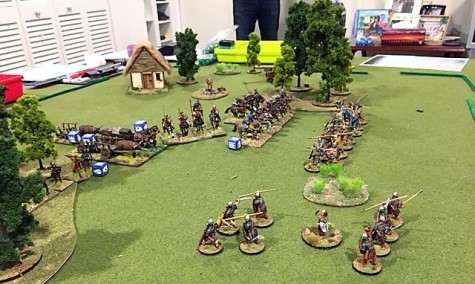
Anglo-Danes catch a Norman supply convoy in a classic hammer-and-anvil ambush
In short, the campaign plays out over six “seasons.” In each season, each player chooses one action (raid, campaign, defend) and one target. Everybody’s actions are compared together on a simple chart that generates the types of games to be played in the season. The whole process takes just a couple minutes. Players are then free to schedule their own games at their convenience within the realtime limits agreed to by the group. Can’t play a game this month? No worries…just pay the Danegeld in money or land and move on to the next season.
The campaign is built around the saga of your warlord. A few die rolls at the beginning of the campaign generate unique skills and traits for your warlord that turn him into something akin to a “Hero of the Viking Age” character. For instance, Tostig Bloodeaxe (my Anglo-Dane warlord) his favored by the gods (and so may roll twice on the post-battle fate table and choose his preferred result) and has a blood feud with another player’s Viking warlord. Tostig also has a “Conqueror” ability that adds attacks to units within M distance if Tostig himself is not in combat. Your warlord’s warband will grow and shrink each season depending upon casualties taken in combat and the result of fate rolls between games.
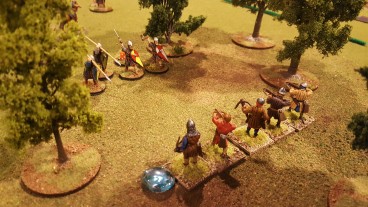
Anglo-Dane hearthguard clear the woods of pesky Norman crossbowmen
Campaign scores are based on your warlord’s accumulation of land, wealth, reputation, and campaign victory points. The first three are usually earned as a result of successful campaigns, raids, and defenses respectively, though there are other options too. For instance, Tostig can gain reputation and wealth if he slays his blood feud target in combat. Pursuit of these various types of points adds depth to individual games. Take our last game for example: though my warband won (leaving behind several burning Norman supply wagons), my opponent actually walked away with bigger gains in reputation and wealth because he fulfilled his blood feud by wounding my warlord.
I won’t go in to all the details of campaign mechanics here. If you want more of those details, you can check out an extended run-down at the Harold’s Revenge blog.
Warbands start at four points, and the composition is limited by the amount of land (levy), wealth (warriors), and reputation (hearthguard) that you warlord collects. Ordinarily, warlords start with two of each (land/wealth/rep), so may select up to two of each type of unit. Players receive limited reinforcements at the beginning of each campaign season. After games, warbands lose figures as permanent casualties at a rate of one for every four models removed during the game. In the post-game phase, some fate roll results deliver reinforcements or unit upgrades. I am still confused about how “units” in the campaign tracker and “units” in the game relate. Can players balance their units in games for optimal dice generation or pursuit of mission objectives, as in a normal game? If so, how does one track which campaign “unit” took casualties? I need to do more reading. For now, we’re letting players reorganize their warbands in game. We then track how many of each type of unit (levy/warrior/hearthguard) took casualties and let the player decide which campaign units lose models permanently.
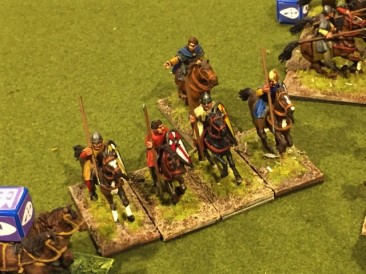
Rogbert the Handsome and his warrior meat-shields go in for the kill against Tostig Bloodeaxe, the Anglo-Dane warlord and unlucky target of a Rogbert’s blood feud.
So, after our first season, would I recommend purchasing AotW? YES! The system is straightforward and simple to manage. Although built for the 1066-set, it could easily be translated for Crescent & the Cross. Plus the price is right at less than $20. In all, we have already gotten a fantastic return on investment in this supplement.
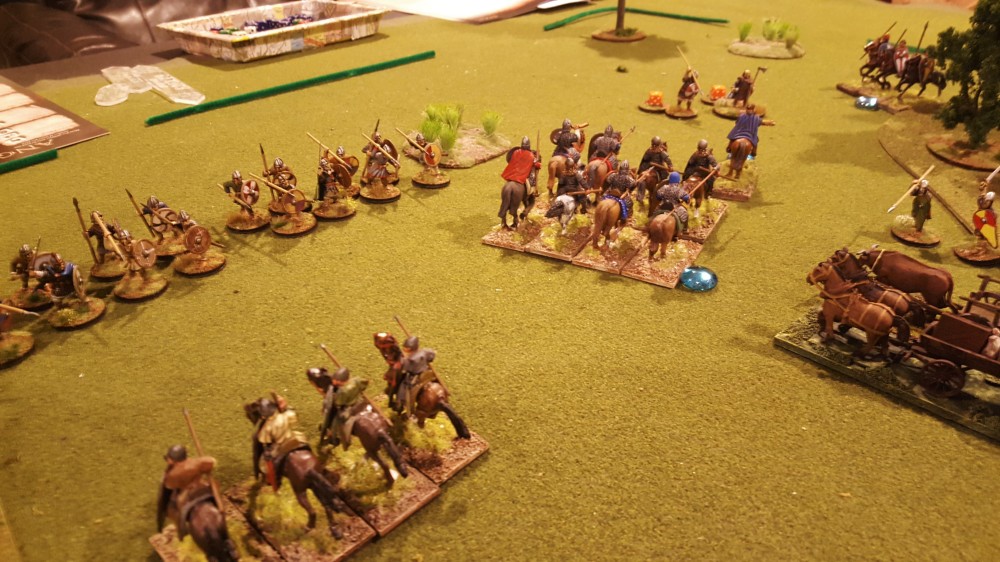
The crucial moment. Tostig desperately fights for his life at the top (he escaped with a flesh wound) while the elite Norman knights confidently ride in for the kill in the center…a little too closely to some Anglo-Dane warriors. The subsequent Lords of Battle assault devastated and exhausted the knights.
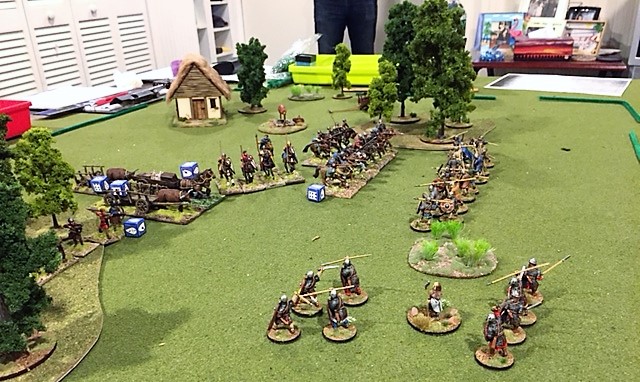
Great review! Thanks.
LikeLike